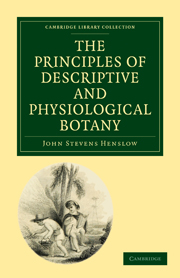Book contents
- Frontmatter
- Contents
- INTRODUCTION
- PART I DESCRIPTIVE BOTANY
- SECTION I ORGANOGRAPHY AND GLOSSOLOGY
- SECTION II TAXONOMY AND PHYTOGRAPHY
- PART II PHYSIOLOGICAL BOTANY
- CHAPTER I VITAL PROPERTIES AND STIMULANTS
- CHAPTER II FUNCTION OF NUTRITION — Periods 1, 2, 3, 4
- CHAPTER III FUNCTION OF NUTRITION — continued — Periods 5, 6
- CHAPTER IV FUNCTION OF NUTRITION — continued — Period 7
- CHAPTER V FUNCTION OF REPRODUCTION — Periods 1, 2, 3
- CHAPTER VI FUNCTION OF REPRODUCTION — continued — Periods 4, 5
- CHAPTER VII EPIRRHEOLOGY, BOTANICAL GEOGRAPHY, FOSSIL BOTANY
- INDEX AND GLOSSARY
CHAPTER I - VITAL PROPERTIES AND STIMULANTS
Published online by Cambridge University Press: 05 December 2011
- Frontmatter
- Contents
- INTRODUCTION
- PART I DESCRIPTIVE BOTANY
- SECTION I ORGANOGRAPHY AND GLOSSOLOGY
- SECTION II TAXONOMY AND PHYTOGRAPHY
- PART II PHYSIOLOGICAL BOTANY
- CHAPTER I VITAL PROPERTIES AND STIMULANTS
- CHAPTER II FUNCTION OF NUTRITION — Periods 1, 2, 3, 4
- CHAPTER III FUNCTION OF NUTRITION — continued — Periods 5, 6
- CHAPTER IV FUNCTION OF NUTRITION — continued — Period 7
- CHAPTER V FUNCTION OF REPRODUCTION — Periods 1, 2, 3
- CHAPTER VI FUNCTION OF REPRODUCTION — continued — Periods 4, 5
- CHAPTER VII EPIRRHEOLOGY, BOTANICAL GEOGRAPHY, FOSSIL BOTANY
- INDEX AND GLOSSARY
Summary
(139. bis.) Vegetable Life — Hitherto we have been occupied with the forms only which the various organs of plants assume, and the manner in which they may be considered to be mutually related. We have been examining merely some of the details of that exquisite mechanism by means of which the vital principle is enabled to act and may be acted upon; and thus produce all the varied and complicated results which the phenomena of vegetation present. In this second part of our treatise, we propose to examine the vegetable machinery in a state of action, and to search for indications of those laws by which vegetable life enables the organic bodies to which it is united to grow and multiply. It would be an unnecessary waste of words to offer any proof that plants are organised bodies endowed with life. No one is so little observant, as to be ignorant of the more general phenomena of vegetation, that plants originate from seed, that they are gradually developed, and, after having attained perfection, that they as gradually decay, die, and are decomposed. In fact the general phenomena of life and death, are scarcely less striking in the vegetable than in the animal kingdom; and probably the vital principle, considered apart from sensibility, is something of the same kind, if not the very same thing, both in animals and vegetables.
- Type
- Chapter
- Information
- The Principles of Descriptive and Physiological Botany , pp. 155 - 174Publisher: Cambridge University PressPrint publication year: 2009First published in: 1835



